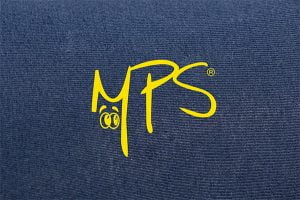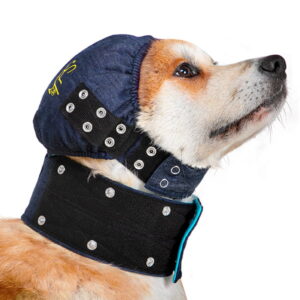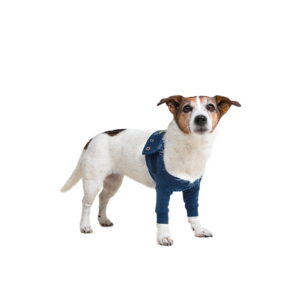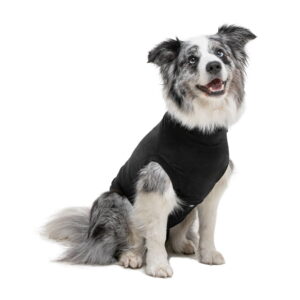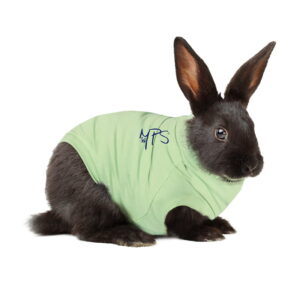Skin Conditions and Hot Spots in Dogs and Cats: How Recovery Suits Help
When your pet can’t stop licking or scratching, you need relief that’s kind and effective. A recovery suit (also called a medical pet shirt, recovery shirt, or dog onesie) is a comfortable, cone-free way to protect healing skin.
Featured snippet quick answer: A dog hot spot (acute moist dermatitis) is a rapidly developing, inflamed, painful skin lesion that becomes moist and can spread within hours. A breathable, properly fitted recovery suit blocks licking and scratching, keeps topical treatments in place, and can help hot spots heal faster than with an Elizabethan collar (the cone of shame) alone.
—
What to Do Right Now if You Spot a Hot Spot (Step-by-Step)
1) Identify: Part the coat and look for a moist, red, oozing patch that’s painful to touch. 2) Clip (if you’re confident): Carefully trim hair around the area to expose the lesion. 3) Clean: Gently cleanse with a vet-approved antiseptic solution; pat dry. 4) Protect: Put on a recovery suit to stop licking/scratching and keep medications where they belong. 5) Monitor: Check twice daily for spreading redness, heat, pus, or a bad odor. 6) Call your vet if the lesion worsens within 24 hours, is very large/painful, or your pet is unwell (see red flags below).
—
What Is a Hot Spot (Acute Moist Dermatitis)?
Hot spots are fast-moving skin lesions triggered by an itch-scratch-lick cycle. Fleas, environmental allergies, moisture trapped under the coat, and even stress can ignite them. Once the skin barrier breaks, bacteria like Staphylococcus pseudintermedius can quickly turn a small irritation into a painful sore. Early protection and airflow are your friends.
—
Understanding Common Skin Conditions in Pets
1) Atopic Dermatitis (Environmental Allergies)
- Signs: Intense itching; red, inflamed skin on paws, ears, belly, armpits; recurrent ear infections.
- Why it happens: A hypersensitive immune response to pollen, dust mites, or mold compromises the skin barrier and invites secondary infections.
2) Allergic Reactions (Food, Fleas, Contact)
- Signs: Hives or red bumps, facial swelling, hair loss from chewing/licking.
- Mechanism: Allergen exposure activates mast cells and inflammatory messengers, leading to itch and self-trauma.
3) Hot Spots (Acute Moist Dermatitis)
- Signs: Moist, oozing sore with odor; very tender; rapid hair loss around the lesion.
- Why fast action matters: Moisture + bacteria + licking equals a lesion that can expand in hours.
—
Recovery Suits vs the Cone: Which Is Better and When?
Looking for a cone alternative for dogs with hot spots? Here’s how a recovery suit stacks up against an e-collar (Elizabethan collar, cone of shame):
- Comfort and stress:
– Recovery suit: Soft, body-hugging; allows normal vision, sleep, and cuddles; lowers stress that can worsen itch. – Cone: Can bump into things, disrupt sleep, and increase anxiety.
- Healing support:
– Recovery suit: Blocks direct licking/scratching; helps hold topical meds or dressings in place; allows airflow with breathable fabrics. – Cone: Prevents direct access but doesn’t protect skin from friction or keep meds on.
- Daily life:
– Recovery suit: Bathroom-friendly designs; easy to eat, drink, and nap. – Cone: Eating and navigating can be awkward; some pets refuse to move.
- Best of both:
– Face/ear/paw issues: A cone may still be needed short-term, paired with a suit for body lesions.
If you need to stop dog licking a hot spot without a cone, a well-fitted recovery suit is often the kinder, more practical option.
—
How Recovery Suits Help (and Why Breathability Matters)
Recovery suits are form-fitting garments made from soft, breathable, often moisture-wicking fabric. They protect without restricting movement.
- Prevents licking, scratching, and chewing: Crucial for hot spots, post-surgery incisions, and atopic dermatitis flare-ups.
- Enhances healing: Reduces self-trauma, keeps ointments on the skin, and minimizes contamination.
- Comfort = compliance: Lower stress can support immune balance and barrier repair.
- Fabric counts: Choose hypoallergenic, stretchy, breathable fabric. In summer, a breathable recovery suit for dogs helps heat and moisture escape; consider pairing with a dry cooling vest for outings.
Popular styles to explore:
- Suitical Recovery Suit for Dogs
- Suitical Recovery Suit for Cats
- MPS Recovery Shirt for Hot Spots
- MPS Single/Double Sleeve for paws/forelegs
- Cooling Vest for summer hot spots
—
How Long Should My Dog Wear a Recovery Suit?
- Hot spots: Typically 3–7 days, or until the area is dry, non-painful, and your vet advises you can stop.
- Atopic dermatitis flare: Wear during active flare-ups or while topicals are in use to prevent self-trauma.
- Post-procedure: Follow your vet’s timeline; many wounds require continuous protection for 10–14 days.
Daily rhythm:
- Aim for near-continuous wear (24/7), removing 2–3 times a day to air the skin, check progress, and change or reapply treatments.
- Have two suits to rotate while one is washed and dried.
—
Sizing and Fitting a Recovery Suit for Dogs and Cats
A snug, not tight, fit is key to comfort and protection.
Measure:
- Back length (collar to base of tail)
- Chest girth (widest point)
- Neck circumference
- Weight (helps confirm the size)
Fit check:
- You should slide two fingers under the fabric at the chest and belly.
- Leg openings should not rub or gape.
- Check bathroom access panels are aligned before heading outside.
Breed-based tips:
- Deep-chested (e.g., Greyhounds): Prioritize chest girth and adjust length with snaps/ties if available.
- Broad-shouldered (e.g., Staffies): Choose the size that matches chest first to prevent strain at seams.
- Cats: A cat-specific cut prevents tripping and reduces stress.
Resources:
- Suitical recovery suit sizing guide
- 60–90s fitting video: How to put on, adjust panels, and bathroom tips
—
Cleaning the Suit and Caring for Sensitive Skin
- Wash after 1–2 days of wear, or sooner if soiled.
- Use a gentle, fragrance-free detergent; avoid fabric softeners that can irritate skin.
- Air-dry or tumble on low to preserve elasticity.
- Summer tip: Choose lighter colors and rotate suits to keep skin cool and dry.
—
When to See a Vet (Red Flags)
Contact your vet promptly if you notice:
- Rapidly spreading redness, swelling, heat, or a foul odor
- Thick discharge, crusting, or significant pain
- Lethargy, fever, loss of appetite, or repeated hot spots
- Ear involvement, swollen face, or hives
- Suspected flea allergy dermatitis or food allergy
—
When Not to Use a Recovery Suit
- Heavy drainage or suspected deep infection without veterinary guidance
- Severe heat stress or inability to thermoregulate
- If your pet becomes distressed in the suit despite gradual introduction
In these cases, follow your vet’s advice; a cone, bandage, or different strategy may be indicated.
—
Seasonal Tips to Prevent Flares
- Spring allergies: Rinse paws after walks; use prescribed anti-itch shampoos; a recovery shirt can reduce over-grooming.
- Summer hot spots: Keep coats dry after swims/baths; combine a breathable recovery suit with a dry cooling vest on hot days.
- Flea allergy dermatitis season: Maintain year-round parasite control; a suit can deter chewing while meds take effect.
—
A Quick Success Snapshot
Meet Georgie: One of our community cats who healed comfortably in a Suitical cat recovery suit—no cone wrestling, just steady progress and lots of naps. Share your story with us on Instagram/TikTok: #conealternative #recoveryshirt.
—
FAQs
Q: Will a recovery suit stop my dog from licking a hot spot? A: Yes. A properly fitted dog hot spots recovery suit acts as a physical barrier, helps hold medications in place, and supports faster healing.
Q: How long should a dog wear a recovery suit for hot spots? A: Usually 3–7 days, or as advised by your vet. Keep it on most of the day, removing a few times daily to check, clean, and air the skin.
Q: Is a recovery suit better than a cone for skin allergies? A: For body lesions, many pets tolerate suits better, which improves compliance and sleep. For face/ears/paws, a cone may still be needed short-term.
Q: Can my dog sleep, eat, and go to the bathroom in a recovery suit? A: Yes. Quality suits include bathroom access panels and are designed for normal eating, drinking, and resting.
Q: What fabric is best for dogs with dermatitis or sensitive skin? A: Soft, stretchy, breathable, moisture-wicking fabrics (often cotton-blend or technical knits) that are hypoallergenic and easy to wash.
Q: Can cats wear recovery suits for dermatitis and hot spots? A: Absolutely. A cat-specific recovery suit can prevent over-grooming and protect medicated areas without the stress of a cone.
Q: Do recovery suits help with ear or paw dermatitis? A: They protect the body and limbs well. For ears and paws, pair the suit with targeted sleeves or, if needed, a short-term cone.
Q: How fast do hot spots heal with a recovery suit? A: Many improve noticeably within 48–72 hours when protected and treated early. Complete healing time varies by size, location, and infection.
—
Friendly reminder This guide is for educational purposes and does not replace veterinary care. If you’re unsure, your vet is the best first call. And when you’re ready, a well-fitted recovery suit can be the gentle, practical cone alternative your pet actually accepts.



